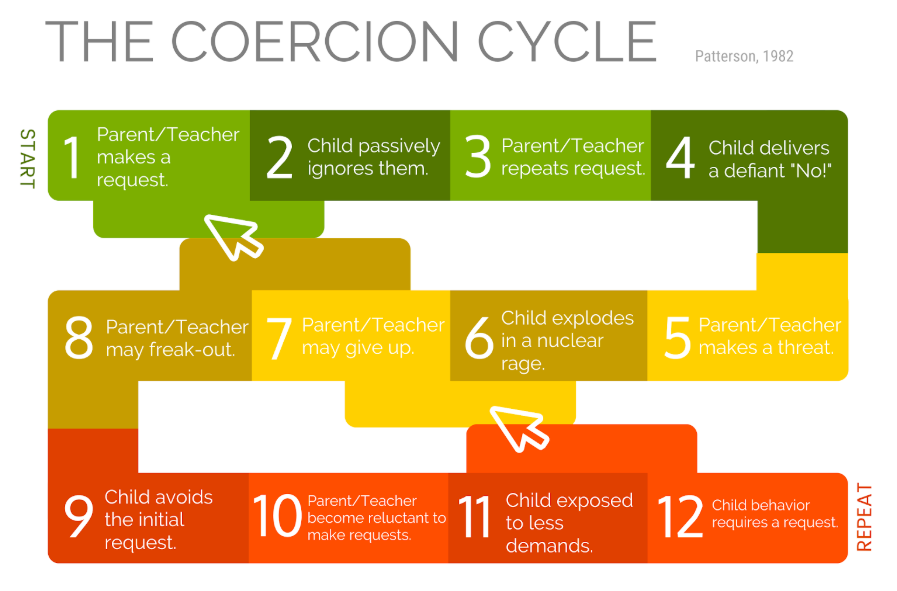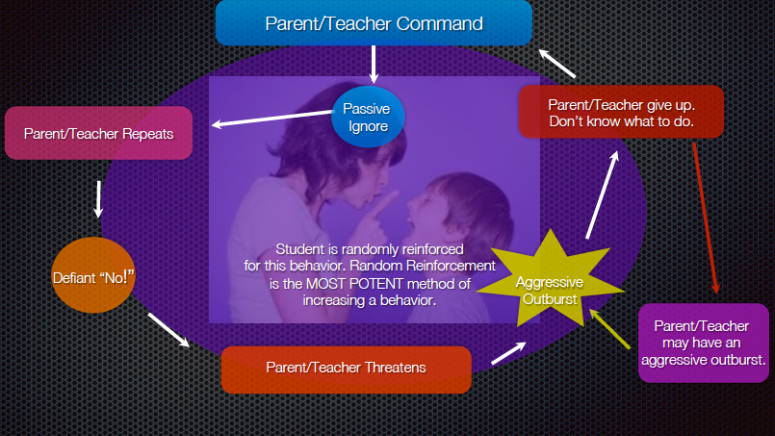Introduction: Random Reinforcement
The coercion cycle has been studied at length. Through these studies, we know that negative behavior persists (and often gets worse) because of random reinforcement.
In response to their behavior, sometimes a student gets something they want (reward) and sometimes they get something they don't want (punishment). Compare it to a Vegas slot machine. We put money in, press a button or pull a lever, and sometimes we get a pay out, and sometimes we just lose the money. People keep putting money into the machine because there is always a chance that they might get what they want. The slot machine is providing random reinforcement and we are willing to gamble on the chance that we might get a payout.
Kids operate in a similar fashion. If they think there is a chance that they will get attention or get out of something they may gamble on it.
What is the Coercion Cycle?
The Coercion Cycle describes how aggressive and antisocial behaviors develop in relationships.

The Coercion Cycle in the Classroom
Scenario: A student who is trying to avoid a task asks to be excused to go to the bathroom. The teacher responds, telling the student "no" and asking the student to get back to work. The student ignores the teacher and ups her effort. This time she tries again either begging "But I really need to go, please may I, please!" or even aggressively escalates "F-you, I want to go, now!"
Remember: the student doesn't know if it will work but it has worked at some point somewhere. We, as the teacher, have a choice to respond in number of ways.
Engaging in the Cycle: Some approaches will continue the coercion cycle. We can ignore the student and eventually throw up our hands and say "Fine, go." We can power struggle with the student and say "I said no, so you better sit down. I'm the teacher, you do what I say.” The student may then escalate more and we end up giving up and removing the demand - slot machine worked.
Breaking the Cycle: Instead, we can break the coercion cycle at the very beginning. When the student asks, we refer to the rules and routines we have taught the students. E.g.: "Johnny, thank you for asking, (positive reinforcement of appropriate behavior) I understand you want to go (empathy). Remember we can't be in the hallways during the first 10 minutes of class/task/etc. You can use the hall pass in 3 minutes! Now, let's look at the equation together."
In this example, the student was given an answer that wasn't a definite and the escape was still available but after a predetermined time. Additionally, we have maintained a positive relationship by offering help. Any conflict and power struggle was taken out of the interaction.
Please note that we cannot prevent students from attending to their basic needs! However, if a student leaves your class for an extended time, at the same time each day, or always during a specific task, it might be beneficial to talk to the student and find out what is happening.

